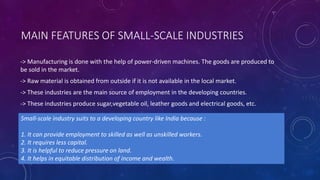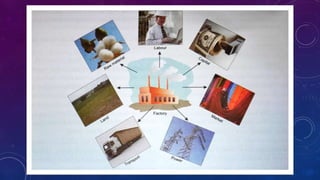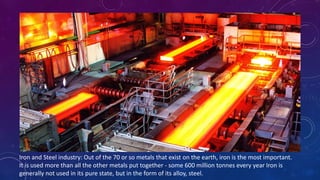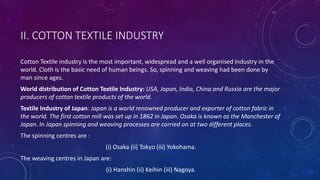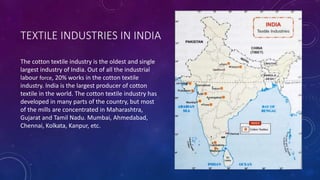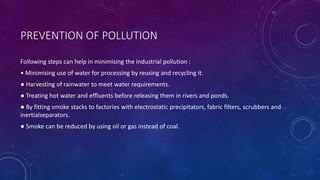Lesson 5 - Industries.pptx
- 2. LEARNING TERMS Manufacturing: Production of goods in large quantities after processing raw material. Industry: Industry is the enhancement of the value of the raw material through the manufacturing process of the factory Large-scale Industry : Large-scale industry is that industry which requires huge capital investment and employs large number of persons with a very high output. Cottage Industry: Cottage industry is that industry in which goods are manufactured by simple processing, byvillage artisan and his family members. Agro-based Industry: Agro-based industry is that industry which gets its raw material from agriculture.
- 3. WHAT IS MANUFACTURING? Production of goods in large quantities after processing from raw materials to more valuable products is called manufacturing. In the early days, the process of manufacturing depended upon craftsmen who made simple things from wood and other metals manually. Prior to the industrial revolution few people were engaged in manufacturing. The manufactured articles were very expensive, so only the rich could afford to buy them. James Watt’s steam engine drove the industrialisation
- 4. NEED OF INDUSTRIES IN THE WORLD. -> With the expansion of world trade, acquisition of colonies in different parts of the world and population growth the demand for goods increased. Cottagers and local manufacturers failed to fulfil the demand. -> Industrialization plays a vital role in the economic development of underdeveloped countries. Industriali sation allows countries to make optimal use of their scarce resources. -> Industrialization stimulates progress in other sectors of the economy. A development in one industry leads to the development and expansion of related industries. -> Industrialisation provides increased employment opportunities in small and large-scale industries. In an industrial economy, industry absorbs underemployed and unemployed workers from the agricultural sector, thereby increasing the income of the community.
- 5. -> Industrialisation provides machinery to the farm sectors, including technologies like tractors, thrashers, harvesters, bulldozers, transport, and aerial spray. The increased use of modern technologies has increased the yield of crops per hectare. The increase in farmers' income boosts economic development more generally. -> Industrialisation provides greater potential for on-the-job training and technological progress. The use of advanced technology increases the scale of production, reduces costs, improves the quality of the product, and ultimately helps to widen the market. -> A series of new inventions in the 18th century set up pace for industrialisation. The earliest factories came up in England in 1730's. With the advent of the industrial revolution, the production increased and cost of production declined.
- 6. TYPES OF INDUSTRIES Industries can be classified on the basis their size, raw material, management and ownership and the nature of the products. (a) Large-scale Industry: "Large-scale industry is that industry which requires huge capital investment and employs large number of workers with very high output." Most of the developed countries of the world like USA, Russia, Germany, Japan, Australia have fully developed large-scale industries. Example of Large-scale Industry in India
- 7. MAIN FEATURES OF LARGE-SCALE INDUSTRY -> It requires large capital investment. -> It employs a large number of workers and consumes vast quantity of power. -> It requires sound infrastructure like roads, refinery, banking, insurance, market, etc. -> The production is on a large-scale. -> Automobile industries, shipbuilding. iron and steel industry and textile industry are some of the examples large-scale industries.
- 8. SMALL-SCALE INDUSTRY Small-scale industry is basically an extended form of cottage industry in which manufacturing is done by machines with the help of a few hired workers. It is also called as SSI In case of India small-scale industries were defined on different basis, but since March 1999, small-scale industries included all those units having a fixed capital of 5 crore invested therein.
- 9. MAIN FEATURES OF SMALL-SCALE INDUSTRIES -> Manufacturing is done with the help of power-driven machines. The goods are produced to be sold in the market. -> Raw material is obtained from outside if it is not available in the local market. -> These industries are the main source of employment in the developing countries. -> These industries produce sugar,vegetable oil, leather goods and electrical goods, etc. Small-scale industry suits to a developing country like India because : 1. It can provide employment to skilled as well as unskilled workers. 2. It requires less capital. 3. It is helpful to reduce pressure on land. 4. It helps in equitable distribution of income and wealth.
- 10. COTTAGE INDUSTRY “Cottage industry is that industry in which goods are manufactured by simple processing, by village artisan and his family members.” Before the industrial revolution cottage industry was present all over the world. The village artisans were fulfilling the needs of the common people. Most of the villagers were self- sufficient due to cottage industries. But the growth of modern industry led to a gradual decline of cottage industry because the products of cottage industry were unable to compete with cheaper and quality articles of modern industry.
- 11. MAIN FEATURES OF COTTAGE INDUSTRY -> The craftsman manufactures goods by using local raw materials with the help of his family members. -> The products are produced for local use. -> Work is done mostly by hands and does not involve use of mechanical power. -> Basket-making, mat-weaving, ropes, pottery, making of simple utensils and furniture are some of the examples of cottage industries.
- 12. AGRO-BASED INDUSTRY Agro-based industry is that industry which gets its raw material from agriculture. Cotton, jute, textile, vegetable oil and tea are important examples of agro-based industries.
- 13. FACTORIES RELATED TO ESTABLISHMENT OF AN INDUSTRY 1. Availability of Raw Material : Availability of raw material is the major factor affecting the location of the industry. An agro-based industry will be located in agriculture dominating areas whereas mineral-based industry will be located in mineral dominating areas. For example, cotton textile mills are located in Maharashtra due to availability of raw cotton. 2. Power: Most of the industries tend to concentrate at the source of power. Though power can be transmitted but those industries which consume large quantities of power are located near the source of power. 3. Labour: Labour is a major input in most types of industries. So labour intensive industries mostly concentrate in densely populated areas or labourers migrate to the industrial centre.
- 14. 4. Transport: Transport system helps in the movement of goods and raw material. Heavy industries like iron and steel industry are located near railway stations or ports so that goods and raw material can be easily transported. 5. Market: The entire process of manufacturing is useless until the finished goods reach the market. Nearness to market is essential for quick disposal of manufactured goods and for purchasing raw material. Nearness to market reduces the cost of transportation. Most of the manufacturing industries concentrate in big cities as these market and other basic infrastructure. 6. Government Policies: Government activities in planning the future distribution of industries, for reducing regional disparities, elimination of pollution of air and water and for avoiding their heavy clustering in big cities, have become an important location factor.
- 16. MAJOR INDUSTRIES OF THE WORLD I. Iron and Steel Industry Iron and steel industry is considered a basic or a key industry since all industries depend on it for their machinery. Iron and steel industry provides inputs to engineering industry, defence industry, machine tools, telecommunication, transportation, agro based industry, computer industry and other manufacturing industries. The production and consumption of iron and steel is often taken as an index of a country's extent of industrialisation. Iron and steel industry is the backbone of economic, industrial and political development of the world. World distribution of Iron and Steel Industry: United States of America, U.K., Germany, France, Italy, Netherlands, Ukraine, Russia, Japan, China and India are some of the major producers of iron and steel. 1. USA: USA is the leading producer of iron and steel in the world. It produces more than 15% of iron and steel of the world. The Great Lakes Region is the largest producer of iron and steel in the country. Pittsburgh, Youngstown, Chicago and Gary are some of the important manufacturing centres of iron and steel.
- 17. Iron and Steel industry: Out of the 70 or so metals that exist on the earth, iron is the most important. It is used more than all the other metals put together - some 600 million tonnes every year Iron is generally not used in its pure state, but in the form of its alloy, steel.
- 19. 2. India : The history of the modern iron and steel industry in India began in 1870 when the Bengal Iron Company Works set up its plant at Kulti in West Bengal. However, the birth of the modern industry began with the establishment of the first iron and steel plant at Jamshedpur in 1907. Major Steel Plants of India At present there are 17 integrated iron and steel plants in India the birth of modem industry in india began with the establishment of the first iron and steel plant the Jamshedpur in 1907 by Jamshetji Tata in 2014/2016 india produced 75.3 MT crude steel and was ranked 4th largest steel producer in the world after China, Japan and the USA. 1. The Tata Iron and Steel Company (TISCO)- Jamshedpur (Jharkhand) 2. Visvesvaraya Iron and Steel Ltd.-Bhadravati (Karnataka) 3. Bhilai Steel Plant - Durg (Chhattisgarh) 4. The Durgapur Steel Plant- Burdwan (West Bengal) 5. The Bokaro Steel Plant – Jharkhand 6. The Rourkela Steel Plant- Sundargarh (Odisha)
- 20. II. COTTON TEXTILE INDUSTRY Cotton Textile industry is the most important, widespread and a well organised industry in the world. Cloth is the basic need of human beings. So, spinning and weaving had been done by man since ages. World distribution of Cotton Textile Industry: USA, Japan, India, China and Russia are the major producers of cotton textile products of the world. Textile Industry of Japan: Japan is a world renowned producer and exporter of cotton fabric in the world. The first cotton mill was set up in 1862 in Japan. Osaka is known as the Manchester of Japan. In Japan spinning and weaving processes are carried on at two different places. The spinning centres are : (i) Osaka (ii) Tokyo (iii) Yokohama. The weaving centres in Japan are: (i) Hanshin (ii) Keihin (iii) Nagoya.
- 22. TEXTILE INDUSTRIES IN INDIA The cotton textile industry is the oldest and single largest industry of India. Out of all the industrial labour force, 20% works in the cotton textile industry. India is the largest producer of cotton textile in the world. The cotton textile industry has developed in many parts of the country, but most of the mills are concentrated in Maharashtra, Gujarat and Tamil Nadu. Mumbai, Ahmedabad, Chennai, Kolkata, Kanpur, etc.
- 23. III. INFORMATION TECHNOLOGY Information Technology covers a vide range of interesting areas inducing the computers, internet, video games, cell phones, robots etc. Since we live in the "information age," information technology has become a part of our everyday lives. India, USA, China, Japan, etc. are the major nations which earns foreign exchange by exporting goods and services related to IT sector. India is the world's largest sourcing destination for the information technology (IT) industry. The industry employs about 10 million workforces. More importantly, the industry has led the economic transformation of the country and altered the perception of India in the global economy. The industry has helped India to transform from a rural and agriculture-based economy to a knowledge based economy. IT sector is one of the fastest growing sector in the world. The top IT companies in the world have companies like IBM, Accenture, Microsoft TCS, Capgemini Oracle, etc.
- 24. The IT sector has emerged as a t global source of both growth , employment. IT industry has played a major role in the process of globalisation. Most of the world markets are in closer contact with each other than a few decades ago. Major andInformation Technology has made its presence in the educational sector too. It helps the students as well as the teacher in studying the course material easily, by enabling faster access to information. Silicon Valley located in San Francisco (United States of America) continues to be the leading hub for this industry. Thousands of high technology companies are head quartered either in or near Silicon Valley. In India Bengaluru the Capital city of Karnataka has been described as a ‘Software Mecca’.
- 25. Wipro Tech is an information technology service company established in India in 1980. It is the global IT services arm of Wipro Limited. It has its headquarter in Bengaluru and is the third largest IT services companyin India. Intel corporation is an American multinational corporation headquated in Silicon Valley. Intel supplies processors for computer system manufacturers such as Apple, Lenovo (formerly IBM), Hewlett Packard, and Dell.
- 26. IV. SUGAR INDUSTRY Sugar is a food additive used in drinks and foodstuffs of all kinds. Approximately 80% of the world's sugar is produced from sugarcane in tropical and subtropical climates, with the remaining 20% derived from sugar beet, which is grown mostly in the temperate zones of the northern hemisphere. Brazil, India, China, Thailand and Pakistan are the major sugar producing nations of the world. Brazil alone accounts for almost 25% of the world's sugar. In India Uttar Pradesh, Bihar, Punjab and Haryana are the leading producer of sugarcane.
- 27. V. SHIP BUILDING It is the industry which is devoted to moving goods or passengers by water. Passenger operations have been a major component of shipping, but air travel has seriously limited this aspect of the industry. Around 90% of world trade is carried by the international shipping industry. Without shipping the import and export of goods on the scale necessary for the modern world would not be possible. Shipping is a private, highly competitive service industry. There are over 50,000 merchant ships tradinginternationally, transporting every kind of cargo. In 2017, nearly 4,000 ships were produced globally, the most of which were manufactured in China, South Korea and Japan.
- 28. Hyundai Heavy Hndustries is the world’s largest shipbuilding industry
- 29. VI. FISHING INDUSTRY The commercial fishing industry is one of the largest, and oldest, market sectors in the world. Fishing industry shows promise for feeding the world's ever-growing population as farmland and soil quality on land are depleted ever further. The fishing industry is ideally suited for those countries with long coastlines. The top fish-producing countries of the world are China, India, Peru, Indonesia, and the US. Millions of people work in the seafood industry, contributing to local, regional andglobal trade on a massive scale and maintaining jobs. Seafood-related jobs include processing, packing, transport, retail and restaurants. Through these diverse businesses, the seafood economy generates financial security for individuals and a valuable source of national income.
- 30. Dogger Bank of North Sea and Grand Bank of Atlantic Ocean are two most important fishing ground of the world.
- 31. VII. AUTOMOBILE INDUSTRY Automobile industry include all those companies and activities involving the manufacture of motor vehicle. The Automobile Industry came of age with Henry Ford adopting assembly line method of production in 1914. The several methods adopted by Ford, made the new invention popular amongst the rich as well as the masses. Today, the modern global automotive industry encompasses the principal manufacturers, General Motors, Ford, Toyota, Honda, Volkswagen, and Daimler Chrylser, all of which operate in a global competitive marketplace. It is known fact that the globalization of the automotive industry, has greatly accelerated during last 20 years. The auto manufacturing industry is considered to be highly capital and labor intensive. China, USA and Japan are the major auto producing nations of the world.
- 32. The automotive industry has become a vital element in the economy of the industrialised countries. Many other industries like rubber, iron and steel, plate - glass manufacturing etc are dependent on the automotive industry. Automotive industry has played a very important role in expanding the world trade market. The mass use of motor vehicles has many unforeseen and undesirable consequences. Motor vehicles contribute a large number of pollutants in the environment and are a major contributor to air pollution and noise pollution. They release carbon monoxide, nitrogen oxide and a large number of hydrocarbons in the air. Even the painting and coating contributes towards severe environmental impact as through mold painting, it releases nickel, chromium, and copper in the atmosphere. Therefore, companies have come up with more eco friendly designs for reducing the environmental pollution as the concept of hybrid cars or green vehicles that run on alternative fuels like ethanol or biodiesel, etc. is being introduced.
- 33. Auto Industry
- 34. POLLUTION DUE TO INDUSTRIES Industry plays an important role in the process of economic development. It enhances the economic welfare of the people by supplying the material and non material goods. But do you know industry is a major consumer resources of natural and a major contributor to the overall pollution load? Pollution has negative effects onbiodiversity, i.e., the number of species in a region. Pollution affects terrestrial and aquatic ecosystems, disrupting the life cycle of animals, plants and other species. It causes biodiversity decline, phytoplankton blooms and an increase in extinction rates. Water pollution cripples the environment, kills the marine life in the area, and leads to the loss of biodiversity. Industry releases harmful gases like sulphur dioxide, carbon dioxide, nitrogen oxide, chlorofluorocarbon (CFC) etc. All these gases are the major cause for lung cancer, asthma, bronchitis, etc. The discharge of all these pollutants into the waterways creates dead zones.
- 35. Industry also causes noise pollution. Noise pollution not only results in irritation and anger, it can also cause hearing impairment, increased heart rate and blood pressure among other physiological effects. Unwanted sound is an irritant and a source of stress. Industry is a huge source of water pollution, it produces pollutants that are extremely harmful to people and the environment.
- 36. PREVENTION OF POLLUTION Following steps can help in minimising the industrial pollution : • Minimising use of water for processing by reusing and recycling it. ● Harvesting of rainwater to meet water requirements. ● Treating hot water and effluents before releasing them in rivers and ponds. ● By fitting smoke stacks to factories with electrostatic precipitators, fabric filters, scrubbers and inertialseparators. ● Smoke can be reduced by using oil or gas instead of coal.








